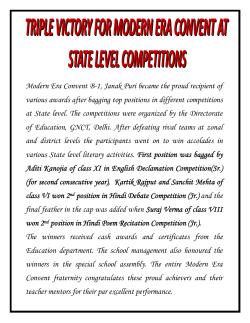
Document 276963
The Annals of Applied Probability
1996, Vol . 6, No . 2, 687-694
THE NUMBER OF WINNERS IN A DISCRETE
GEOMETRICALLY DISTRIBUTED SAMPLE
BY • PETER KIRSCHENHOFER AND HELMUT PRODINGER
Technical University of Vienna
In this tutorial, statistics on the number of people who tie for first
place are considered. It is demonstrated that the so-called Rice's method
from the calculus of finite differences is a very convenient tool both to
rederive known results as well as to gain new ones with ease .
Let the random variable G be geometrically distributed . That is, P{G = k}
with q = 1- p . Also, assume that n independent copies are given .
Finally, let X count the number of random variables with highest value . A
popular realization of this situation is to consider n "players" who independently toss coins until each of them sees the first head . In this interpretation,
X is the number of players who gain their respective heads in the very last
round of the game, that is, the "winners" of the game . In [1] the probability
distribution of X, the expectation EE X of X and the asymptotic behavior of
P{X = 1} (probability of a single winner) for n were to be determined . In
the solution [2] it was remarked that-surprisingly-this probability does
not converge as n -> 0o but rather has an oscillating behavior . At the same
time, Eisenberg, Stengle and Strang [5] discussed this problem and related
topics, exhibiting the structure of the periodic fluctuation, for which an
explicit Fourier expansion was given . Also about this time, Brands, Steutel
and Wilms [4] came independently to roughly the same results . A recent
paper by Baryshnikov, Eisenberg and Stengle [3] deals with the existence of
the limiting probability of a tie for first place .
In fact, a fluctuating behavior in asymptotic expansions is not at all
uncommon . There are numerous results of that type, for example, in the
analysis of divide-and-conquer recursions [7, 8, 16] or digital sums [6], that
play a prominent role in the probabilistic analysis of algorithms .
Our aim in this paper is to some extent tutorial : the asymptotic technique
that yields the Fourier expansions of the fluctuating functions very comfortably is called "Rice's method" (see the recent survey [9]) . In order to convince
the reader of the advantages of this method, we will rederive a result on the
initially mentioned problem in the sequel, and afterwards present some new
results concerning higher moments of distribution as well as the number of
persons reaching a specified level beyond the winner(s) .
= pqk-1,
Received October 1994 ; revised November 1995 .
AMS 1991 subject classification . 60C05 .
Key words and phrases. Geometric distribution, generating functions, Rice's method .
687
688
P . KIRSCHENHOFER AND H . PRODINGER
log Q . Also, let pm denote the
Let us abbreviate Q
1/q and L
that
is,
the
probability
of having m winners
probability Pm = P{X = m},
.
Then
(amongst n players)
(1)
q j-1 ) n-m
=P°'(m'
(
l j,Lr ~I (j-1)m 1
P,,,
This follows from the observation that m out of n people have a (winning)
n - m,
value j, while the other ones have a smaller value . Now we set N
expand the binomial and sum over j to get the alternative formula
N
(2)
pm
- pm
m
1
N
k=o
k
( -1 )
k
1_ Q-
m
The key point in analyzing this alternating sum asymptotically is the following lemma.
Let f(z) be a function that is analytic on [n o ,+ x[ . Assume
LEMMA 1([9]) .
that f(z) is meromorphic in the whole o f C and analytic on = U .
where the y~ are concentric circles whose radius tends to 00 Let f(z) be of
polynomial growth on f . Then, for N large enough,
N
(3)
N
(-1) k f(k) _
Res[N ; z] f(z),
z
k=n O (k)
where
!
-
-1N
[N ;z] _
r N+ i)r(-z~
z(z-1) • •• ( z-N)
_
I'(N+1-z)
and the sum is extended to all poles not on [n0, + x[ .
The following proposition collects the asymptotic results concerning the
distribution of the number of winners among n players . We demonstrate the
use of Rice's method by giving our alternative proof for the asymptotics of the
probabilities, mention the (known) expectation and derive the (new) asymptotics of the variance .
PROPOSITION 1 . Let X be the random variable "number o f winners among
n players" as described above . Then
pm
( 4)
(5)
_ P{x = m}
1 p
"Z
p "`
Lm + L
n1
Sm(1ogQn)-h
m fixed, n -> 00 ,
9
E n = E X= q L ~1+S 1 (log Q n)) +(-)
WINNERS IN A GEOMETRICALLY DISTRIBUTED SAMPLE
689
and
Vn = Var X
(s)
P
i
Qi
PZ 1
?' 2 L
42
+ 7 1 (log Qn)
)I
L
~>_
j_ 1 i (Q~' +
1)
n
where 6m (X) and 7 1(x) are continuous periodic functions of period 1, mean 0
and small amplitude .
PROOF . In order to prove (4), we apply the lemma (with no = 0) to
expression (2) . In this instance f(z) = 1/(1- Q -z- m) has poles at z =
- m + Xj, with x j = 2 jir i/L, and is bounded on concentric circles Cj about
the origin passing through the points
(2j+1)iri
-m±
L
= 1, 2, . . . .
Therefore we only have to consider the residues of
1
[N; z] 1
Q
-z-m
at z =
- m + X3.
The computation of the residues is simple ;
Res z=-m+X3 -
FN+1)r(m-x) 1
I'(N+ 1 +m -x) L'
whence we have [after multiplication by the factor
pm(n) and going back to
n > m instead of N > 1] the formulas
(7)
1 pm
F(n + 1)
~ ~F(m-Xj )
L m . jE~
r(n + 1 X~)
pm =-
n>m
where according to the previous remarks-the series stands for the Cauchy
principal value .
Using Stirling's formula for the approximation of the F-functions, we find
that
I'(n+l)
X(
( 111
_ni ~1+6~
~,
F(n + 1 -x3 )
1n~1
l
n-°°,
so that, for n getting large, the series converges to the Fourier expansion of a
periodic function in log Q n. Pulling out the term with index j = 0 (the
"mean") and denoting the remaining periodic fluctuation (of mean 0),
6m(X)
we gain formula (4).
_ 1
F(m m. j o
690
P . KIRSCHENHOFER AND H. PRODINGER
It is interesting to note that the alternating sum (2) can also be rewritten
using the partial fraction decomposition of the meromorphic function 1/(1qz+m), namely,
11
1 _ q z+m
2
(8)
1
1
Lz+m+Xj
with Xj =
2 jir i
L
(Compare [11], 7 .10 .) Again, the sum stands for the Cauchy principal value .
The usual argument to derive (8) is to compute the sum of the principal parts
of the function and to show that the difference between this sum and the
function-which has to be entire is bounded, and thus a constant . Inserting
(8) into (2), we find
N
P,,, =
P °'( m)
Now, for x e
r'
1
N
~ ( k )( - 1) k12 + LP °`( m)
=0
je7L k=0
1
) -
k+m+Xj
C\{ -N, . . . , 0},
N1
I'(N + 1)I'(x)
N!
()_1
~ k+x r(N+l+x~ - (N+x)(N+x-1)x
.. .
(compare [101, (5 .41)), so that (remembering
1 pm
pm
pm
N = n - m)
n!
n, m +
L m .I FEZ m+Xj )
n+Xj )
pm
1 pm
I'(n+ l)
I'( m
Sn, m + -)
2
L m! jEa
X' I'(n + 1 - X~)
2
(9)
In order to get (5), we observe that En = Q(p 1 - p 6n,1) as was already
reported in [2] . Let us now engage in the proof of (6) . For this we compute the
second factorial moment Mn for n > 2 :
Mn =
2m(m-1)pm
m>_ 2
n(n-1)
10)
-
j) n-m
I n-2 p m
g
Jm
(
1q
m~2 l m-2
j>_0
F
n(n - 1) p 2
a-z
q2 ~, q2(1 _ q)
j>1
n(n 1)p2
-2 n - 2
qz
~ ( k )~ -1 ) Qk+z _ 1
= 2Q 2p2
PZ
2 2 6n,2
9
2Q 2 (p2
p 26n,2) •
WINNERS IN A GEOMETRICALLY DISTRIBUTED SAMPLE
The variance is obtained in the usual way by computing Vn = Mn
Hence
(11)
Vn=q2
L+qL-q 2 L2
691
+ E n - E, .
+T(log Qn)+Y(n) .
t
This time
p22
T(x) =
q2 -5
L 2(x)
p 1
+
--5
qL 1( x )
2 1 2
q2 L2 51 (x)
p
_
has (integral) mean different from 0! While this quantity is quite small, it can
be extracted using the methods described in [12], and we find the alternative
formula (6) of the proposition . 0
There is a nice way to derive the explicit forms of the expectation and the
second factorial moment, using (probability) generating functions . Let the
coefficient of z k in Fn (z) denote the probability that n players produce k
winners . We get the following recursion :
(12)
(n) p n-kg kFk(z) + p n z n,
k
Fn ( z)
n
1.
It is convenient to set F0 (z) = 1 . This recursion is almost self-explanatory .
When, at a certain level, the remaining players all fail, we label each of them
by a "z" and leave the recursion (equivalently we might think of z as the
probability of an event independent of the game) . The expectation En is
obtained via F,(1) ; therefore
n
En = ~ (nk )p n-k g kEk +np n ,
k=1
Defining the exponential generating function
tain
n >_ l .
E(z) = E n , En z'/n!, we ob-
E(z) = epzE(gz) + pzep z .
Using the "Poisson transform"
zn
E(z) = e -ZE(z) _
n>_1
n.
this simplifies to
qz) + pze _
qz .
Equating coefficients we see that, for n > 1,
En =
np
gn
(- 1) n_1
q
1-q n
P . KIRSCHENHOFER AND H . PRODINGER
692
n > 1,
and furthermore, for
n
n )Ek
k
( k) q (_l)k
k~
Qk -
1
1
11 ( _ l) k
Q k+1 - 1
k
which coincides with the formula in [2] . For the second factorial moment we
differentiate twice and evaluate at z = 1 . An almost identical computation
gives the same expression that we obtained already.
This approach was used by Knuth in [15] under the name "binomial
transform" and subsequently used by many people (see, e .g., [17]) .
Finally, we want to produce some additional new results which shed some
additional light on the original question about the number of winners .
Assume that the winners have reached the level j . We are interested in the
number of players who reached the level j - d, where d is a parameter.
(d = 0 is the case that was just considered .) Call the random variable in
question Xd . Then we have the following proposition .
Let Xd denote the random variable "number of players
who reach level d below the winners ." Then
PROPOSITION 2 .
~~ Xd
l
_
n
- mdl -
(13)
J>d+1
( m,
~ . . .,md, µ
. . .(pqi_d_1)m'1(1
X (pg j_1 ) mo
where the first sum runs over all
m o - . . .- md,
(14)
F' nd~
1
- L
1
p2
q'
mo
p2
+ L Q,d+
l
>
1,m 1 >-
q i_d-1)µ
0, . . . , an d _ 1 > 0 and j = n
'l\
)
S1(1ogQn) + ~( n
and
2
Vn(d)
=
p
2d+2
q
1
L (1 + q
d+1
) _ q
4
p
2d+2
(1
+ Tld~(log Q n)
PROOF . The formula for the probabilities is self-explanatory [compare the
comments on formula (1)] . The expected value is just the sum of an d times
WINNERS IN A GEOMETRICALLY DISTRIBUTED SAMPLE
693
this quantity. We get
n
=
1) n-1
pq j-d-1 (pqj-1 + . . . +pq j-d-1 + 1- qi-d _
n
j>d+1
- (pq j- 2 +
q j_d_ 1
= pn
(1-
q J - d - l) n-1 ]
-d-1 +1 -
.
q J_1 \n - 11
q j ) '1 - ~/ 1 1
j>_d+1
p2
j 1- qi)n-1- p n
d o-1
n ~)
q (
( 1- q
qd+1 j>d
q
This formula holds only for d >- 1 . Since
j
j
E~° ~ - En p ~q(1-q)'',
n
-n
q >1
we find
(16) nE=
2
d-1
- p
n
j
E~°)
~ q( 1- qj) n-1 - p n(1- qd) o-1
d o
d+1
q
q
=1
q
p
and, because the extra terms are exponentially small, we can use the asymptotic result for En° ~ and have
p
E~'
=
q d+ 1p1 + exponentially small terms in
n
n >- 2,>
from which (14) is immediate using (4) . The second factorial moment Mn d ~ for
1 is computed analogously as (with Mn° ~ = Mn )
d>
-
Mnd~
=
n(n -
1)
(pqi_d_1)2[(i
- q') n-2 - (1 - q j _ 1) n-2
j>_d+1
p3
(17)
=
2
d)o -2
-1
2
j1j
n-2-p
2d+ 2n(n
) ~ q (
q )
2 n( n-1)(1- q
q
j> d
q
q2d n
+ exponentially small terms in n
n - 00 ..~
Thus formula (15) gives us the asymptotics for the variance . 0
REFERENCES
[1] E3436 (PROBLEM) (1991) . Amer . Math. Monthly 99 366 .
[2] E3436 (SOLUTION) (1994) . Amer . Math . Monthly 10178-80 .
[3] BARYSHNIKOV, Y., EISENBERG, B . and STENGLE, G . (1995). A necessary and sufficient condition for the existence of the limiting probability of a tie for first place . Statist. Probab .
Lett . 23 203-209 .
[4] BRANDS, J . J . A. M., STEUTEL, F . W . and WILMS, R . J. G. (1994). On the number of maxima
in a discrete sample . Statist . Probab . Lett . 20 209-217 .
[5] EISENBERG, B., STENGLE, G. and STRANG, G . (1993). The asymptotic probability of a tie for
first place . Ann . Appl . Probab . 3 731-745.
694
P. KIRSCHENHOFER AND H . PRODINGER
[6] FLAJOLET, P., GRABNER, P ., KIRSCHENHOFER, P ., PRODINGER, H . and TICHY, R . F. (1994) .
Mellin transforms and asymptotics : digital sums . Theoret. Comput. Sci .123 291-314.
[7] FLAJOLET, P. and RICHMOND, L . B . (1992). Generalized digital trees and their differencedifferential equations . Random Structures and Algorithms 3 305-320 .
[8] FLAJOLET, P . and $EDGEWICK, R . (1986). Digital search trees revisited . SIAM J. Comput.15
748-767 .
[9] FLAJOLET, P . and SEDGEWICK, R . (1995) . Mellin transforms and asymptotics : finite differences and Rice's integrals . Theoret . Comput . Sci .144 101-124 .
[10] GRAHAM, R ., KNUTH, D . E . and PATASHNIK, 0 . (1989) . Concrete Mathematics. Addison-Wesley, Reading, MA.
[11] HENRICI, P . (1977) . Applied and Computational Complex Analysis 1 . Wiley, New York .
[12] KIRSCHENHOFER, P . and PRODINGER, H . (1991) . On some applications of formulae of Ramanujan in the analysis of algorithms . Mathematika 3814-33 .
[13] KIRSCHENHOFER, P, and PRODINGER, H . (1993) . A result in order statistics related to probabilistic counting. Computing 51 15-27 .
[14] KIRSCHENHOFER, P ., PRODINGER, H . and SZPANKOWSKI, W. (1989) . On the variance of the
external pathlength in a symmetric digital trie . Discrete Appl . Math . 25 129-143 .
[15] KNUTH, D . E . (1973). The Art of Computer Programming 3 . Addison-Wesley, Reading, MA .
[16] MAHMOUD, H. M . (1992) . Evolution of Random Search Trees . Wiley, New York .
[17] PRODINGER, H . and SZPANKOwSKI, W . (1993) . A note on binomial recurrences arising in the
analysis of algorithms (letter to the editor) . Inform . Process . Lett . 46 309-311 .
[18] SZPANKOWSKI, W . (1988) . The evaluation of an alternative sum with applications to the
analysis of some data structures . Inform . Process . Lett . 2813-19 .
INSTITUT Fi R ALGEBRA UND DISKRETE MATHEMATIK
TECHNISCHE UNIVERSITAT WIEN
WIEDNER HAUPTSTRASSE 8-10 / 118
A-1040 WIEN
AUSTRIA
E-MAIL : Kirsch@rsmb.tuwien .ac .at
p roding@rsmb .tuwien .ac .a t
© Copyright 2025





















